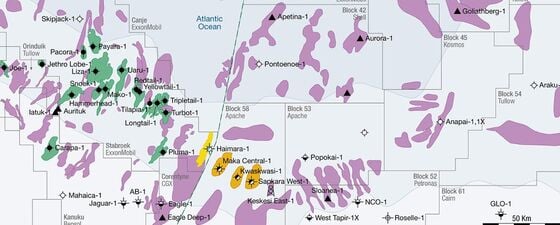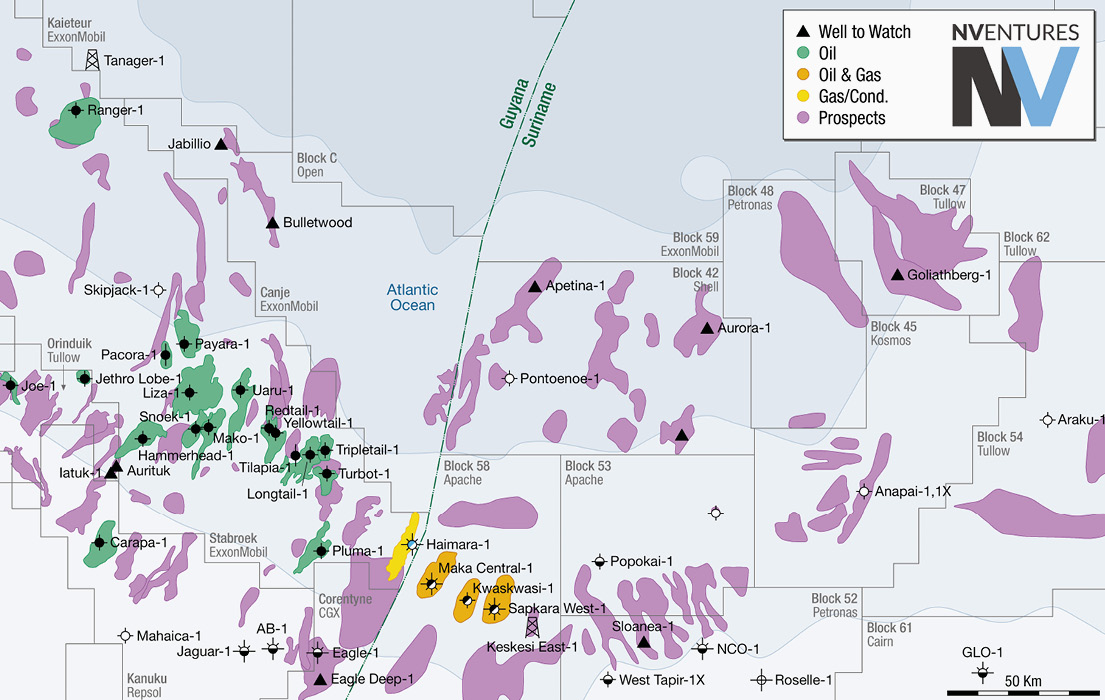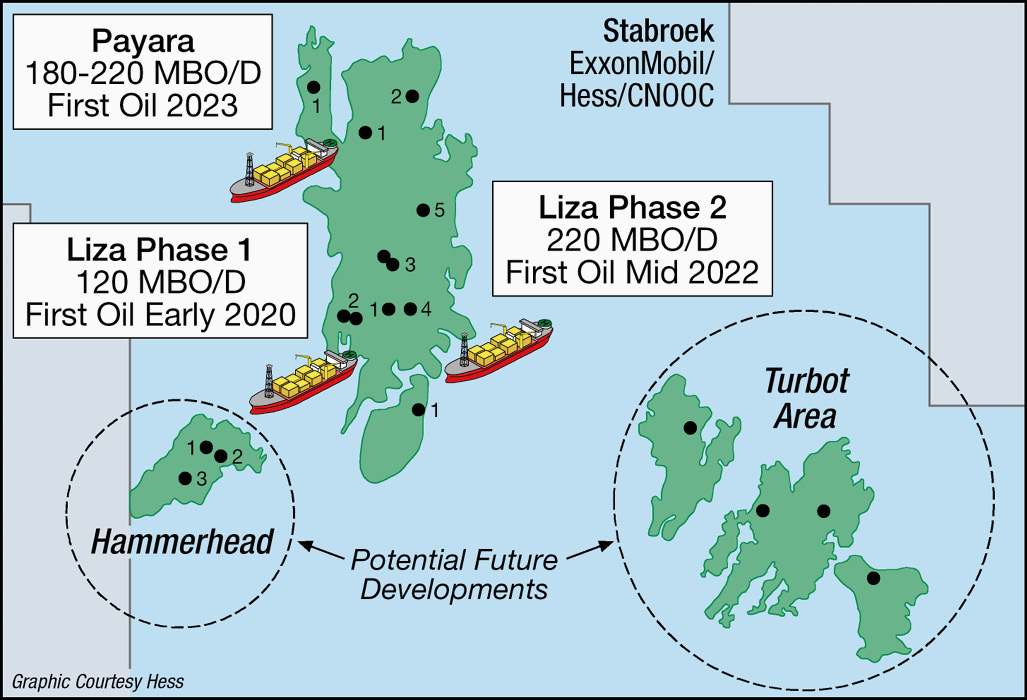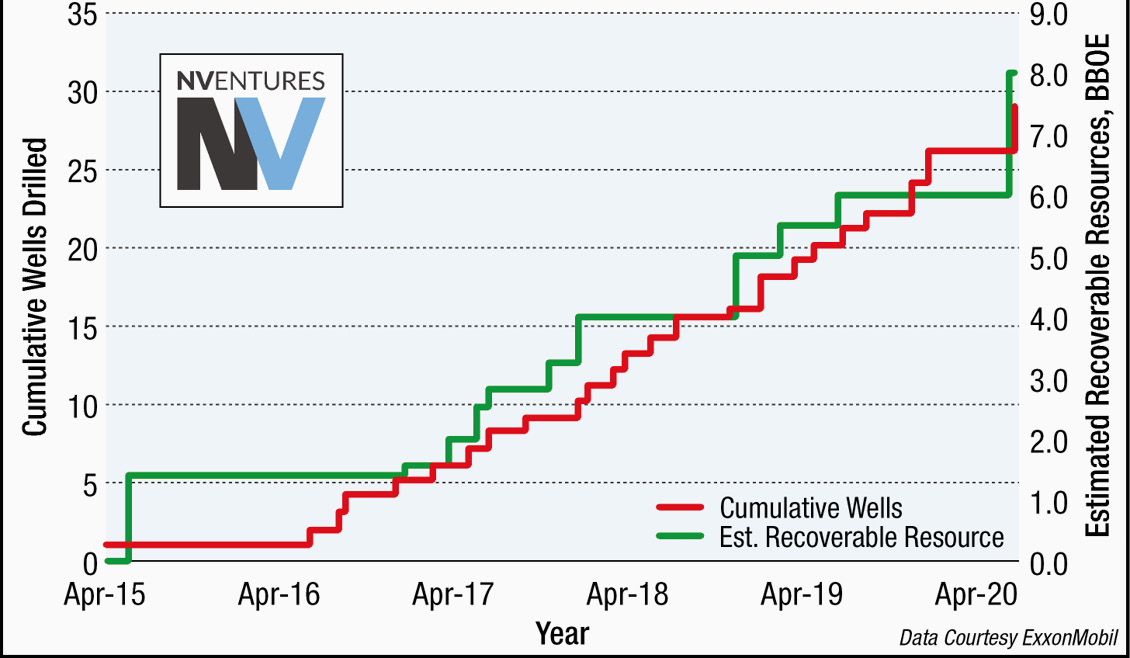Building on the sterling success at Kwaskwasi-1 in Suriname Block 58 (see GEO ExPro Vol. 17, No. 4 – Hydrocarbon Exploration Suriname: Perseverance Rewarded) Apache are looking to go four for four – and extend this exciting trend to the southeast with Keskesi East-1. Along trend to the north-west on the Guyana Stabroek Block, ExxonMobil have reported their 18th discovery with the Redtail well, logging 70m light oil in sands with the usual high permeability, while appraisal well Yellowtail-2 found a new zone logging 21m pay. In addition, Shell are re-entering the action by acquiring the Suriname interests of Kosmos.
Hydrocarbon Discovery Trends in Guyana-Suriname
While operators are understandably keeping logs and seismic close to their chest, numerous press releases allow us to characterise developments since the original Liza-1 discovery in May 2015. Here are some takeaways: On the Stabroek Block the ExxonMobil group, which includes Hess and CNOOC, have drilled 29 exploration and appraisal wells plus Liza development wells in between 1,150 and 2,200m of water about 180 km offshore in benign sea conditions. TDs have ranged from 4,225m to 6,450m, averaging about 5,450m. Excluding a few wells that had extensive coring and logging, we estimate it takes 20 to 100 days to reach TD, averaging about 50 days, although Hess reports that development wells are taking less than 30 days, and now cost less than $60 million. ExxonMobil have announced an astounding 18 discoveries and only two dry holes. In this clastic channel-fan stratigraphic trap complex some wells designated exploratory might turn out to be linked, but all seven appraisal wells have been successful, so this is an extraordinary feat of AVO calibration – 27 of 29 wells have logged pay in this emerging basin.
The successful wells have from 18m to 93m net pay from multiple zones in the Upper Cretaceous, averaging 51m. The oil is low-sulphur with APIs in the low 30°s, except Haimara-1 on the south-east end of the trend, which encountered gas condensate. No flow rates are noted, but Hess cites permeabilities ranging up to 4 Darcys and porosities commonly over 30%. The group also made the Ranger discovery in carbonates, which has now been successfully delineated.
Estimates of recoverable hydrocarbons discovered is now over 8 Bboe, increasing with E&A drilling from an initial 1.4 Bboe. Given these factors, Hess touts a world-beating breakeven oil price of $25/bo for Liza Phase 2, or $7boe development costs, resulting in payback in five years for each development at a $45/bo price. The Liza Phase 1 development went online last December, just 55 months after discovery – unheard of for a province-opening deepwater FPSO development. The group hopes to reach 750,000 bopd with five to six FPSOs by 2026, which would be another a world-class performance.
Apache’s high-profile success along trend on adjacent Block 58 in Suriname is in similar water depth, but TDs are a little deeper, from 6,300m to 6,645m, taking an average of 82 days to reach TD. Pay zones are presumably correlative to Stabroek in the Upper Cretaceous, somewhat evenly distributed in the Campanian and Santonian, but deeper and containing light volatile oil and gas condensate. API gravities range from 34° to 43° and gas–oil ratios from 967 to 1,178. The 278m net pay in the Kwaskwasi-1 is high for the trend, and the three wells average 160m of pay, compared to the 51m for Stabroek. At the end of the day it will be really interesting to see which block will have the best returns. Apache is logging more pay, but the zones are somewhat deeper and under higher pressure, so the wells are taking more time to drill, hence presumably more expensive. Furthermore, can Apache and Total reach the Turonian on Block 58 to test that play?
Upcoming Exploration Activity in Guyana-Suriname
Both wells drilling now – ExxonMobil’s Tanager-1 (on a new block, Kaieteur) and Apache’s Keskesi-1 – can potentially extend the trend in both directions. An upcoming well by Petronas could further extend the trend to the south-east in Suriname. Also, BHP recently spudded Broadside-1 in Trinidadian Block TTDAA 3, outboard of their recent gas success in that country, targeting deeper oil zones that may be part of the same petroleum system as on Stabroek. ExxonMobil’s Ranger discovery is midway between Broadside and Keskesi. The main challenge for exploration teams in a number of companies is to now prioritise their prospect inventories with this growing database
Further Reading on Oil & Gas Exploration in Guyana-Suriname
Hydrocarbon Exploration Suriname: Perseverance Rewarded
This exploration update is brought to you in association with NVentures
Perseverance pays off; following two high-profile, high-cost dry holes drilled in Suriname, Apache hit their third consecutive major conde.
This article appeared in Vol. 17, No. 4 – 2020
The Guyana–Suriname Connection
Brought to you in association with NVentures
Following the trend and showing that the Canje source kitchen does not stop at borders.
This article appeared in Vol. 17, No. 3 – 2020








